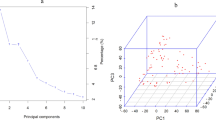Abstract
Isogenic diploid and tetraploid alfalfa (Medicago sativa L.) was studied with molecular markers to help understand why diploid performance and breeding behavior does not always predict that of tetraploids. In a previous study of partially heterozygous alfalfa genotypes, we detected a low correlation between yields of isogenic diploid (2x) and tetraploid (4x) single-cross progenies, and genetic distances were more highly correlated with yields of tetraploids than diploids. These differences may be related to the level of RFLP heterozygosity expected among progenies derived from heterozygous parents at the two ploidy levels. The objectives of this study were to determine the relationships among genetic distance, forage yield and heterozygosity in isogenic 2 x and 4 x alfalfa populations. Four diploid genotypes were chromosome doubled to produce corresponding isogenic autotetraploids, and these genotypes were mated in 4 × 4 diallels to produce 6 single-cross families at each ploidy level for field evaluation. Allele compositions of parents were determined at 33 RFLP loci by monitoring segregation of homologous restriction fragments among individuals within progenies, and these were used to estimate RFLP heterozygosity levels for all single-cross progenies at both ploidy levels. RFLP heterozygosity rankings were identical between progenies of isogenic diploid and tetraploid parents; but significant associations (P < 0.05) between estimated heterozygosity levels and forage yield were detected only at the tetraploid level. Since tetraploid families were nearly 25% more heterozygous than the corresponding diploid families, inconsistencies in the association between molecular marker diversity and forage yields of isogenic 2 x and 4 x single crosses may be due to recessive alleles that are expressed in diploids but masked in tetraploids. The gene action involved in heterosis may be the same at both ploidy levels; however, tetraploids benefit from greater complementary gene interactions than are possible for equivalent diploids.
Similar content being viewed by others
References
Allard RW (1960) Principles of plant breeding. John Wiley & Sons, New York
Bingham ET (1980) Maximizing heterozygosity in autopolyploids. In: Lewis WN (ed) Proc Int Conf Polyploidy: Biol Relevance. Plenum Press, New York, pp 471–489
Bingham ET (1983) Maximizing hybrid vigour in autotetraploid alfalfa. Ciba Found Symp 97:130–141
Bingham ET, Groose RW, Woodfield DR, Kidwell KK (1994) Complementary gene interactions in alfalfa are greater in autotetraploids than diploids. Crop Sci 34:823–829
Boppenmaier J, Melchinger AE, Brunklaus-Jung E, Geiger JJ, Herrmann RG (1992) Genetic diversity for RFLPs in European maize inbreds: I. Relation to performance of flint x dent crosses for forage traits. Crop Sci 32:895–902
Brummer EC, Kochert G, Bouton JH (1991) RFLP variation in diploid and tetraploid alfalfa. Theor Appl Genet 83:89–96
Brummer EC, Bouton JH, Kochert G (1993) Development of an RFLP map in diploid alfalfa. Theor Appl Genet 86:329–332
Chyi Y-S, Hoenecke ME, Sernyk JL (1992) A genetic linkage map of restriction fragment length polymorphism loci for Brassica rapa (syn campestris). Genome 35:746–757
Dunbier MW, Bingham ET (1975) Maximum heterozygosity in alfalfa: results using haploid-derived autotetraploids. Crop Sci 15:527–531
Echt CS, Kidwell KK, Knapp SJ, Osborn TC, McCoy TJ (1994) Linkage mapping in diploid alfalfa (Medicago sativa). Genome 37:61–71
Godshalk EB, Lee M, Lamkey KR (1990) Relationship of restriction fragment length polymorphisms to single-cross hybrid performance of maize. Theor Appl Genet 80:272–280
Kidwell KK, Austin DF, Osborn TC (1994a) RFLP evaluation of nine Medicago accessions representing the original germplasm sources for North American alfalfa cultivars. Crop Sci 34:230–236
Kidwell KK, Woodfield DR, Bingham ET, Osborn TC (1994b) Molecular marker diversity and yield of isogenic 2x and 4x single-crosses of alfalfa. Crop Sci 34:784–788
Kiss GB, Csanadi G, Kaiman K, Kalo P, Okresz L (1993) Construction of a basic genetic map for alfalfa using RFLP, RAPD, isozyme and morphological markers. Mol Gen Genet 238:129–137
Lamkey KR, Hallauer AR, Kahler AL (1987) Allelic differences at enzyme loci and hybrid performance in maize. J Hered 78:231–234
Lee M, Godshalk EB, Lamkey KR, Woodman WW (1989) Association of restriction fragment length polymorphism among maize inbreds with agronomic performance of their crosses. Crop Sci 29:1067–1071
McCouch SR, Kochert G, Yu ZH, Wang ZY, Khush GG, Coffman WR, Tanksley SD (1988) Molecular mapping of rice chromosomes. Theor Appl Genet 76:815–829
Nei M (1972) Genetic distance between populations. Am Nat 106:283–292
Pfeiffer TW, Bingham ET (1983) Improvement of fertility and herbage yield by selection within two-allele populations of tetraploid alfalfa. Crop Sci 23:633–636
Price SC, Kahler AL, Hallauer AR, Charmley P, Giegel DA (1986) Relationships between performance and multilocus heterozygosity at enzyme loci in single-cross hybrids of maize. J Hered 77:341–344
Quiros CF, Morgan K (1981) Peroxidase and leucine-amino peptidase in diploid Medicago species closely related to alfalfa: multiple gene loci, multiple allelism, and linkage. Theor Appl Genet 60:221–228
Rohlf FJ (1992) NTSYS-pc: Numerical taxonomy and multivariate analysis system. Version 1.70. Exeter Software, Setauket, N.Y.
SAS Institute (1988) SAS language guide for personal computers. Release 6.03. SAS Institute. Cary, N.C.
Sedcole JR (1977) Number of plants necessary to recover a trait. Crop Sci 17:667–668
Slocum MK, Figdore SS, Kennard WC, Suzuki JY, Osborn TC (1990) Linkage arrangement of restriction fragment length polymorphism loci in Brassica oleracea. Theor Appl Genet 80:57–64
Smith JSC, Smith OS (1991) Restriction fragment length polymorphisms can differentiate among US maize hybrids. Crop Sci 31:893–899
Steel RGD, Torrie JH (1980) Principles and procedures of statistics. McGraw-Hill, New York
Author information
Authors and Affiliations
Additional information
Communicated by A. R. Woodfield
Present address: AgResearch Grasslands, New Zealand Pastoral Agriculture Research Institute, Palmerston North, New Zealand
Rights and permissions
About this article
Cite this article
Kidwell, K.K., Bingham, E.T., Woodfield, D.R. et al. Relationships among genetic distance, forage yield and heterozygosity in isogenic diploid and tetraploid alfalfa populations. Theoret. Appl. Genetics 89, 323–328 (1994). https://doi.org/10.1007/BF00225162
Received:
Accepted:
Issue Date:
DOI: https://doi.org/10.1007/BF00225162




